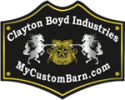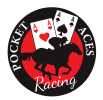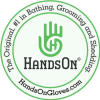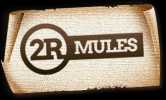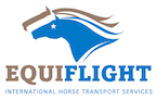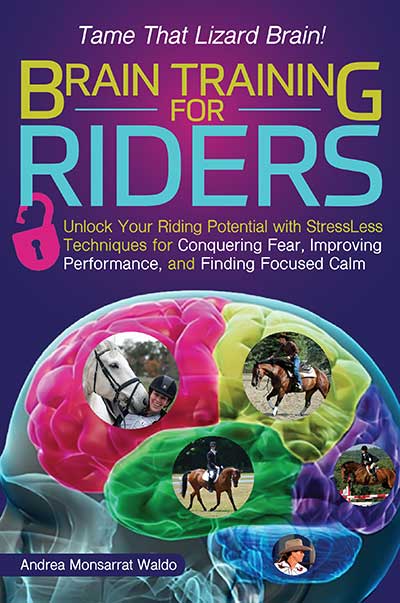
by Andrea Monsarrat Waldo
Here are a few common mismatches that I see (or have experienced myself) between horses and riders. Some feel like you’ve been accidentally miscast in a romantic comedy, while others are worthy of full horror-flick status. See if any of these feel vaguely, or not-so-vaguely, familiar.
He’s Green—and so Are You
You have just started riding in the last couple of years, or you’ve taken it up again recently after riding a little bit in your childhood. You looked at a couple of schoolmaster types, but they were all older and needed a fair amount of maintenance. And they were, well, kind of plain. You found a gorgeous three-year-old that was as sweet as could be, and the seller said it was the easiest youngster she had ever worked with. You don’t have the opportunity to take regular lessons, but you do ride in an occasional clinic, so you figured you could get some guidance there if you got stuck.
Unfortunately, though, it’s not progressing as smoothly as you thought it would. The horse has started getting really pushy on the ground, and you’re having a hard time controlling him under saddle. He has started to test you with misbehaviors here and there, and you’re worried, because they seem to be escalating in their intensity.
Even “straightforward” young horses are a challenge if you have never trained your own horse before. They really are blank slates, and they don’t know what you’re asking for. If you know how to ride but you don’t know how to develop a training system for a green horse, it’s easy to confuse him; if you aren’t 100 percent sure what to ask for and how to ask, he won’t understand what he’s supposed to do.
Green horses are also unpredictable by nature; they haven’t developed an attention span or a work ethic yet, so they’re easily distracted or spooked. Like toddlers who have just learned to walk, they can move incredibly fast in random directions, and get away from you quicker than you ever thought possible. And they’re strong. Training a youngster can be deeply rewarding, but it can also go very wrong if you aren’t sure how to go about it.
The Horse for the Rider You Wish You Were
You’re 5’1” and just learning to sit the trot. Your ambition is to ride Grand Prix dressage someday. You wish you were tall and elegant with long legs, able to float along in perfect harmony with your equally elegant horse. Your trainer urged you to get a lovely 15.2-hand Welsh cross, but you were afraid you would look silly in the warm-up ring among all those big, gorgeous Warmbloods. You buy a 17.2-hand Hanoverian with an enormous trot. You can’t sit to that trot, and his power feels kind of overwhelming, but he’s so gorgeous….
Unfortunately, you’re not going to be 5’10” someday, unless you’re 12 years old at the moment. Yes, Carol Lavell was petite and her Olympic dressage champion, Gifted, was 17.3, but we remember that about them because they were the exception, not the rule. Having a horse that suits your body type, especially if you are first developing your seat, makes everything easier and much, much more fun.
The other mismatch here is in temperament: you choose an off-the-track Thoroughbred because you’d like to be a rider who loves speed, excitement, and flash. You’re truly happiest when you ride your friend’s horse that feels like a well-broken-in pair of jeans, but maybe this time you’ll find true love with the Glamour Boy in the sports car….
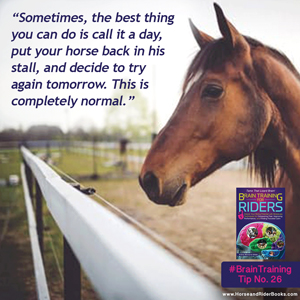
If you’re hard-wired to love security, the James Dean Thoroughbred will never do anything but scare you; if you crave speed and excitement, that Belgian draft cross is unlikely to do it for you, no matter how well he jumps. You are who you are, and as long as you are safe riding the horse that suits your personality, he’s the one for you.
The Three-Years-from-Now Horse
This is the horse that many parents want for their kids, the one that’s showing three or four levels above the kid’s ability level, “One that she can grow into, so we don’t have to keep buying and selling horses as she progresses.”
You can buy a pair of boots for a child that are two sizes too big, and they will grow into them in short order, usually with no ill effects besides a blister or two. Horses, however, don’t work this way. More advanced horses are usually more sensitive to the aids, so they do exactly what you tell them to do—whether you meant to tell them that or not. With a less experienced rider, one of two things is likely to happen with a much more advanced horse: 1) He will object strenuously to your lack of experience, or 2) he will eventually regress to your ability level.
I couldn’t have ridden my current horse if it hadn’t been for the Irish mare I’d had before I bought him. The mare was a “4” on a “1-to-5” scale of sensitivity, and he is definitely a “5”; what I learned from Bailey was essential before I was ready to handle Chauncy.
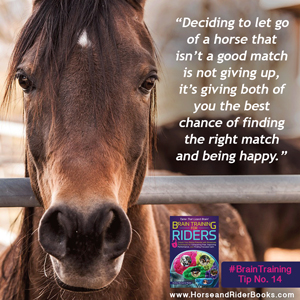
A horse that challenges you at the edge of your ability can definitely improve your riding, but if he is too far above your current level, you may become overwhelmed, and your comfort zone will shrink rather than expand. At this point you may be thinking, “Hey, Andrea, didn’t you just rave in the last chapter about how great it is to have a schoolmaster?” Yes. And it is. The difference between a schoolmaster and the three-years-from-now horse is that a schoolmaster can take a joke. A schoolmaster has a “been there, done that” attitude, and tends to be unfazed when we blunder about, learning the ropes.
The three-years horse, on the other hand, takes it personally when we aren’t up to scratch; he is more sensitive and picky about how he is ridden, which leads to him feeling annoyed and to us feeling overmounted. And I say “us” very deliberately—I tried one of these before I bought Chauncy. Luckily for both of us, he had the sense to run away with me when I tried him out on cross-country so that I was under no illusions that he would be my schoolmaster!
This excerpt from Brain Training for Riders by Andrea Monsarrat Waldo is reprinted with permission from Trafalgar Square Books (www.horseandriderbooks.com).
Find out more about horse training in our section on Health & Education. Find this book and others in our section on Entertainment / Books.








